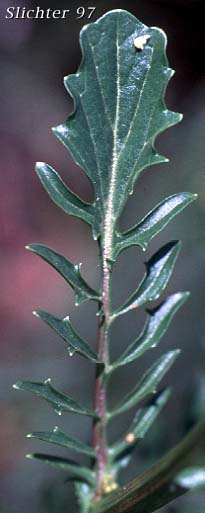 Photo at right of a stem leaf
of the american wintercress.
Photo at right of a stem leaf
of the american wintercress.
American wintercress is a biennial with a taproot, and single, erect stem to 60 cm in height. The stems are stiff and often branched. The basal leaves are long-petiolate, with oblong-elliptic to subcordate or lyrate-pinnatifid shapes. When pinnatifid, 2-10 lateral lobes or leaflets may be present. The stem leaves are similar, but become reduced in size upwards on the stem. The basal leaves may be up to 12 cm long.
The inflorescence may be a single terminal raceme, or more generally compound, with smaller racemes seen in the lower leaf axils. The 4 sepals are a pale yellow-green, while the 4 petals are yellow, spatulate-oblanceolate in shape, and from 3-5 mm long. The seed capsules are an erect or ascending, silique, from 1.5-5 cm long and 1.5-2.5 mm wide.
American wintercress is a wildflower of moist forests, meadows, and streambanks.
American wintercress is found from Alaska east to Labrador and New England, and hence south to the mountains of southern California.
In the Columbia River Gorge, it is found from the western mouth of the gorge east to just west of The Dalles, OR. It may be seen between the elevations of 100'-2600'.